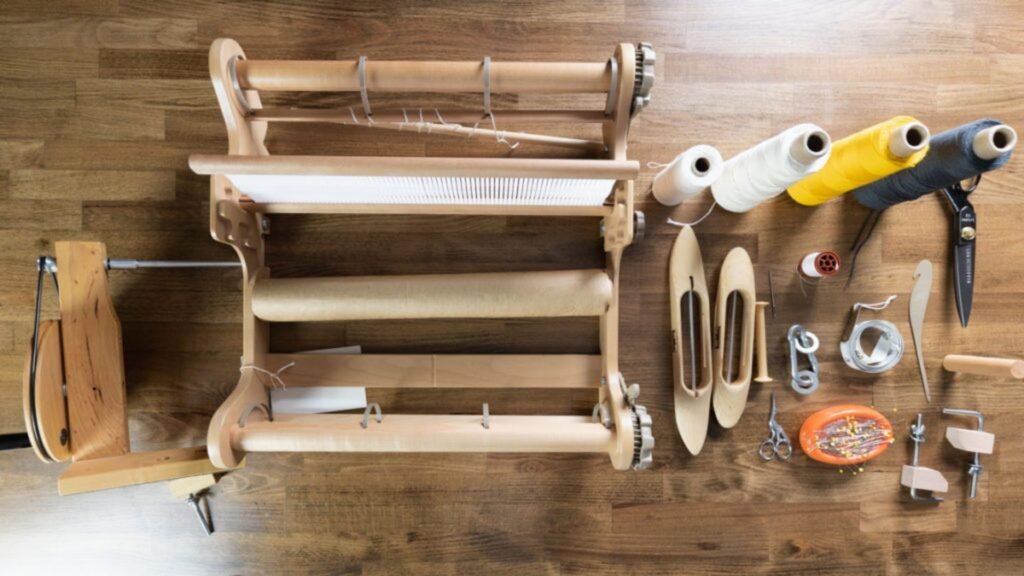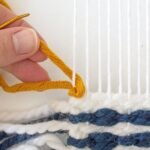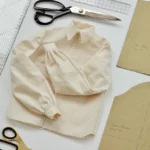Weaving is a timeless craft that combines creativity with craftsmanship. Whether you’re interested in making textiles, tapestries, or decorative items, understanding the essential tools and techniques is the first step to successful weaving. Here’s a comprehensive guide to help you get started with weaving.

Understanding Weaving Basics
Weaving involves interlacing threads or yarns to create fabric. The two primary components in weaving are:
- Warp: The vertical threads held taut on the loom.
- Weft: The horizontal threads woven over and under the warp.
Essential Weaving Tools
Loom:
- Types of Looms:
- Frame Loom: Simple and portable, suitable for beginners and small projects.
- Rigid Heddle Loom: Versatile for a variety of projects, offering more control over the weaving process.
- Floor Loom: Larger and more complex, ideal for advanced weavers and larger projects.
- Choosing a Loom: Select a loom based on the size of your projects and your space. Frame looms are great for beginners, while floor looms are suited for more ambitious weaving.
Weaving Shuttle:
- Purpose: The shuttle carries the weft yarn through the warp threads.
- Types: There are various types, including boat shuttles, stick shuttles, and rag shuttles. Boat shuttles are popular for their smooth, efficient weaving.
Warping Tools:
- Warping Board/Frame: Helps measure and wind the warp threads evenly.
- Threading Hook: Assists in threading the warp yarns through the loom’s heddles and reed.
Beat and Comb Tools:
- Reed (or Heddle): Separates the warp threads and helps pack the weft yarn into place.
- Beater: Used to push the weft yarn securely into place, ensuring even tension across the fabric.
Yarn and Threads:
- Choosing Yarn: The type of yarn affects the texture and appearance of your woven fabric. Common yarns include cotton, wool, and synthetic blends.
Basic Weaving Techniques
Setting Up the Loom:
- Warping: Measure and wind your warp yarn onto the loom. Ensure that the threads are evenly spaced and tightly secured.
- Threading: Pass the warp threads through the heddles and reed according to your loom’s instructions.
Weaving the Fabric:
- Basic Weave Patterns:
- Plain Weave: The simplest pattern, where the weft yarn goes over and under each warp thread alternately.
- Twill Weave: Creates diagonal patterns by shifting the weft yarn over and under the warp threads in a specific sequence.
- Satin Weave: Produces a smooth, glossy surface by floating the weft yarn over multiple warp threads.
- Techniques:
- Tension Control: Maintain even tension on both the warp and weft threads to avoid distortions in your fabric.
- Selvages: Ensure the edges of your fabric are neat and consistent by adjusting the tension and using a beater.
Finishing the Fabric:
- Removing from Loom: Carefully cut the fabric from the loom, making sure to secure the edges to prevent unraveling.
- Finishing Techniques: Depending on the yarn and project, you may need to wash, iron, or trim the fabric to achieve the desired finish.
Troubleshooting Common Issues
- Warp Breakage: Check for tension imbalances and ensure that the warp threads are properly aligned.
- Uneven Weft: Adjust the tension and technique with the beater to ensure an even weave.
- Frayed Edges: Use a selvage technique or finish the edges with a zigzag stitch to prevent fraying.
Expanding Your Skills
- Experiment: Try different yarns, patterns, and techniques to develop your unique weaving style.
- Join a Community: Engage with local or online weaving groups for tips, inspiration, and support.
Conclusion
Getting started with weaving involves selecting the right tools, understanding basic techniques, and practicing patience. By familiarizing yourself with essential tools like looms, shuttles, and yarns, and mastering foundational techniques, you can create beautiful woven textiles. Keep experimenting and learning to enhance your skills and enjoy the rewarding process of weaving.











